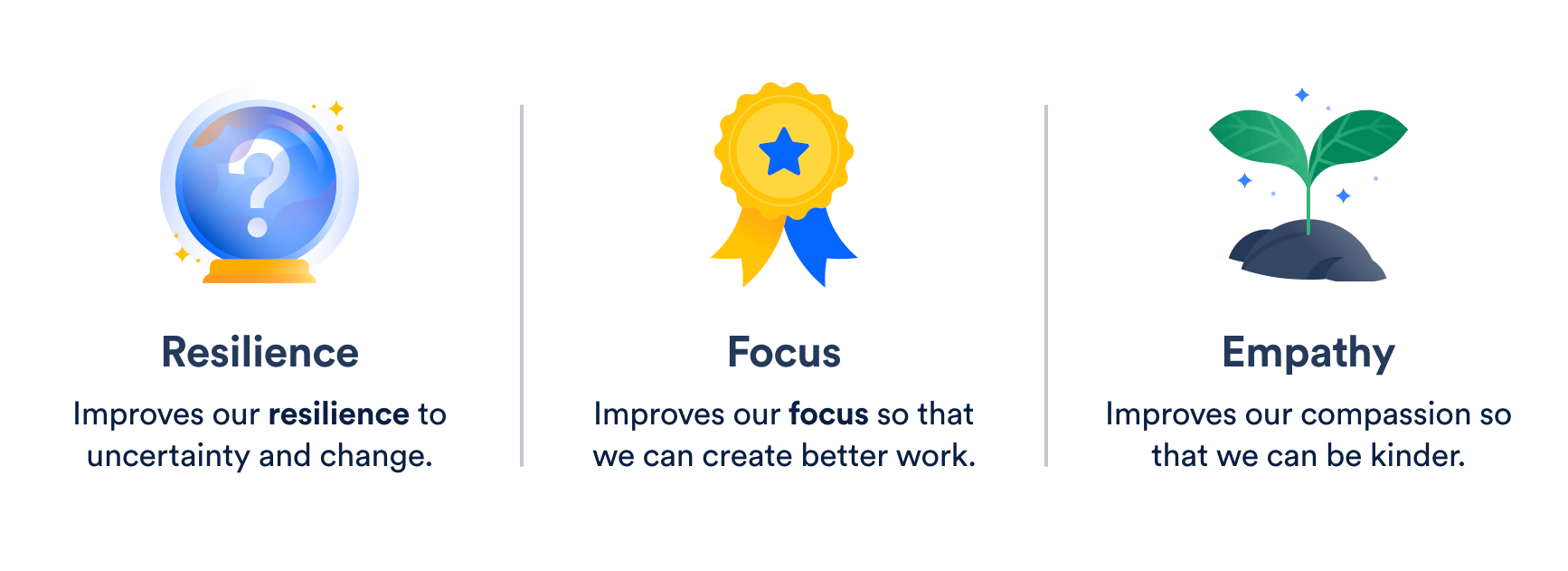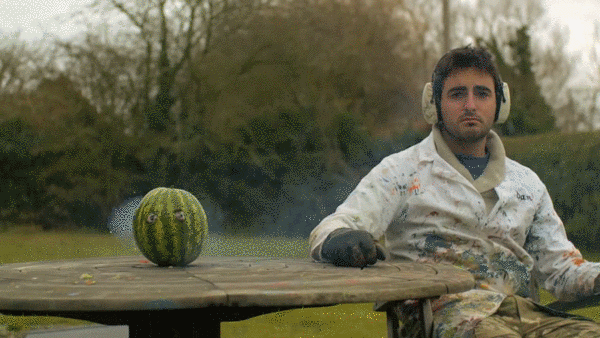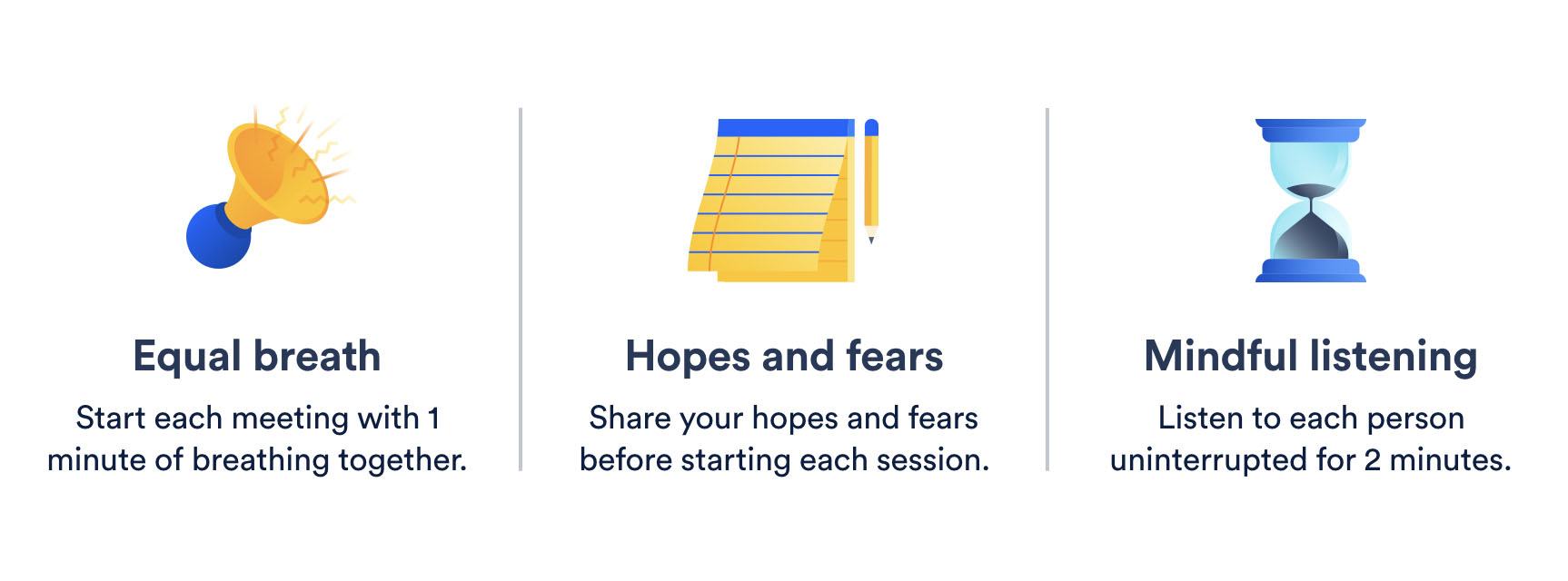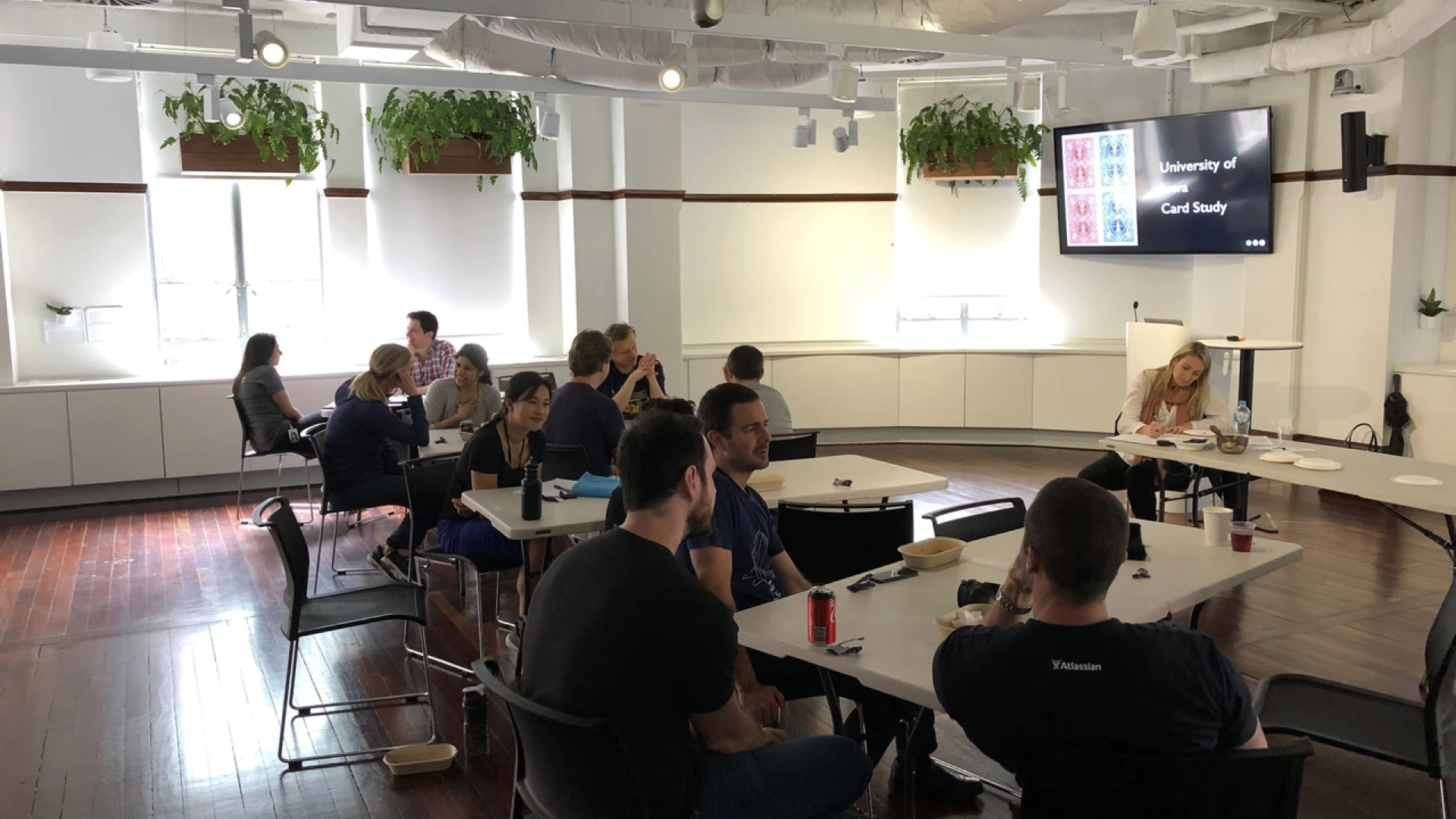Mindfulness for teams
May 2018
Write up from my talk at Managing Design 2018, link to slides.
I’m super excited to share with you something that is close to my heart, which is mindfulness. And how to introduce mindfulness to your team to unleash their full potential. How many times are you half way through a meeting and you are still thinking about the last one, or what you are going to have for lunch today? I know I’ve been there. How much time have you or your team wasted on meetings because people were not present?
At Atlassian, we believe that behind every great human achievement, there is a team. And our mission is to unleash the potential of every team. And I feel like my role as a Design Team Lead is to unleash the potential of my team 👇.

Preparing for the zombie apocalypse.
Let me give you a bit of background about me and my journey into mindfulness. I played American football in college, and my freshman year my coach recommended that I try Yoga as a way to increase my flexibility. I had a lot of other things on my mind at the time, the least of which was signing up for yoga, but I did anyway. Ultimately this decision started me down the path to mindfulness which I would come to realize years later.

Most people hear mindfulness, and they think a monk in meditation, but in reality, mindfulness is more like Jedi training. It’s the ability to hone your mind to pay attention to the present moment. It sounds simple, but it is tough to do. How often do you think about work when you are at home with your family or out with friends? Wouldn’t it be great to be able to let those thoughts go and be present with the people you love?
But why does this matter? A recent research study from Microsoft indicates that our average attention span has fallen in the last two decades from twelve seconds to eight seconds. To put that in comparison goldfish have an attention span of around nine seconds. This is where mindfulness comes in. The best way that I have heard mindfulness defined is from Jon Kabat-Zinn.
Mindfulness is awareness that arises through paying attention, on purpose, in the present moment, non-judgementally. It’s about knowing what is on your mind.
And who wouldn’t want to know what is on their mind? Mindfulness is typically thought of as a technique for self-improvement, but it can have a massive impact on your professional life and those of your teammates. If you have ever managed or worked with someone who has a traumatic event occur in their life, such as the death of a loved one, you know how much that can impact their ability to work. It’s not possible to separate work and life; the one affects the other. If one suffers they both suffer.
In most organizations today, people are faced with increasing expectations and a high degree of uncertainty, leading to stress 😰, anxiety 😭 and burnout 🔥.
Throughout my career, I’ve experienced one of those three, if not all three at once, on many occasions. When I first started working I remembering being obsessive, as most designers are about every little detail and any little bump in a project would throw me into a tailspin. I still definitely have my off days, but I handle change and uncertainty much better now, in large part due to mindfulness.
And this isn’t a small problem for businesses. A report from Medibank estimates that stress costs Australian companies over 10 billion a year, as a result of absenteeism, reduced productivity levels, and employee turnover. And a study out of the Yale Center for Emotional Intelligence found that one in five highly engaged employees experience burnout, often resulting in them leaving their organization.
How often do you replay that last conversation you had with our boss or worry about a project that slipped? We talk about finding flow a lot, and this is a topic that has been brought up quite a bit recently. And as important as it is to turn off your Slack notifications, batch your emails, and block out your calendar, the thing that interrupts flow the most is our minds.

Mindfulness improves our resilience to uncertainty and change, our focus so that we can create better work, and our compassion so that we can be kinder. Everybody could benefit from being a little more mindful, especially if you are a people leader.

Think back to a time that you didn’t respond in a way that you are proud of, take a few minutes to think about it. For some of you remembering that moment might feel a little like ☝️. Now imagine that you have a superpower to go back and slow down time, what would you have done differently? Imagine being able to pause and think before you act, to not be reactive, how would you respond instead. Mindfulness is that superpower.
To be clear, mindfulness is not something that you can master; it is not something you can pick up and put down and expect to get the benefits of. Similar to working out it’s something that requires dedicated practice to see the results. Here are three mindfulness techniques that you can start to introduce to your team.

🧘 Equal breath
Equal breathing soothes your sympathetic nervous system, which is responsible for fight or flight, it quits the monkey brain and has a general calming effect. It is often helpful to have someone lead the meditation or listen to a guided meditation the first couple of times.
So let’s give it a shot. Find a comfortable position in your chair. Set a timer for one minute and start by inhaling through your nose for a count of four, then exhale through your nose for a count of four. Find this rhythm of equal breath. Draw awareness to your breathing. Sense the air feeling and expanding your lungs. Feel free to close your eyes if that suits you.
🛎 Now open your eyes and bring your awareness back to the room. How did that feel? For some of you, you might feel calmer, more relaxed. Wouldn’t it be nicer to start your meetings feeling that way?
✍️ Hopes and fears
Again, mindfulness is about knowing what is on your mind. One of the best ways to do this is through making time for reflection. So when starting a new project or kicking off a design sprint with your team, a helpful technique that you can use is hopes and fears. This technique gives people an opportunity to share their feelings, gives you as a leader a chance to show vulnerability, and helps build trust amongst the team.
🛎 Set a timer for one minute and let the team write down on post-it notes what they hope the outcome will be, reset the timer for another minute and have them write down what the fear will happen. Discuss as a team and see if any patterns emerge. Put actions in place to help achieve the things your team hopes will happen and block the things they fear from happening. Do you have a better understanding of what is on your mind and the teams?
👂 Mindful listening
When was the last time you had 2 minutes were no one interrupted you in a meeting, or vice versa you gave your full attention to the person talking? Get into pairs with the person next to you. For the person speaking, feel free to talk about whatever comes to mind, anything at all, this is your time. For the person listening, devote your full attention to this moment, actively listen to what the person next to you is saying, but don’t interject, just listen. Set a timer for two minutes, the person with the shortest hair speaks first, after two minutes switch.
🛎 How did it feel to talk for two minutes uninterrupted, and to listen for two minutes to somebody without saying a word? Was it hard not to give advice? Could you feel your mind start to wander off?
To recap, these are just three mindfulness techniques that you can take back and incorporate with your team. You can start each meeting with a moment of breathing, you can build trust by discussing each other’s hopes and fears, and you can mindfully listen to each other.

We’ve started a program for mindfulness training at Atlassian that teams can sign up for that is two hours a week for four weeks. We’ve had over a 100 people participate with the vast majority recommending the program. In fact, other companies such as Com Bank, IBM, eBay, GoPro, and LinkedIn all have similar initiatives. And a study in 2016 from Fidelity showed that roughly 1 in 5 companies had mindfulness training programs in place. Companies are not just adopting this, but professional sports teams and the military all have mindfulness programs as well.
Everyone thinks of changing the world, but no one thinks of changing themselves.
My ask of you is to strive to embody the ideals that you want to see exemplified within those around you. If you do not see those, first take a look at yourself. For mindfulness and compassion to thrive within your team, you need to embody it. Your emotions like most things are contagious if you show up everyday stressed and anxious, your team is going to pick up on it. Your actions signal if this behavior is acceptable, so lead with your best self.
Subscribe to updates